Mandu are delicious Korean dumplings filled with pork, cabbage, chives and Korean glass noodles. This homemade mandu recipe will help you make juicy dumplings from scratch with these step-by-step instructions.
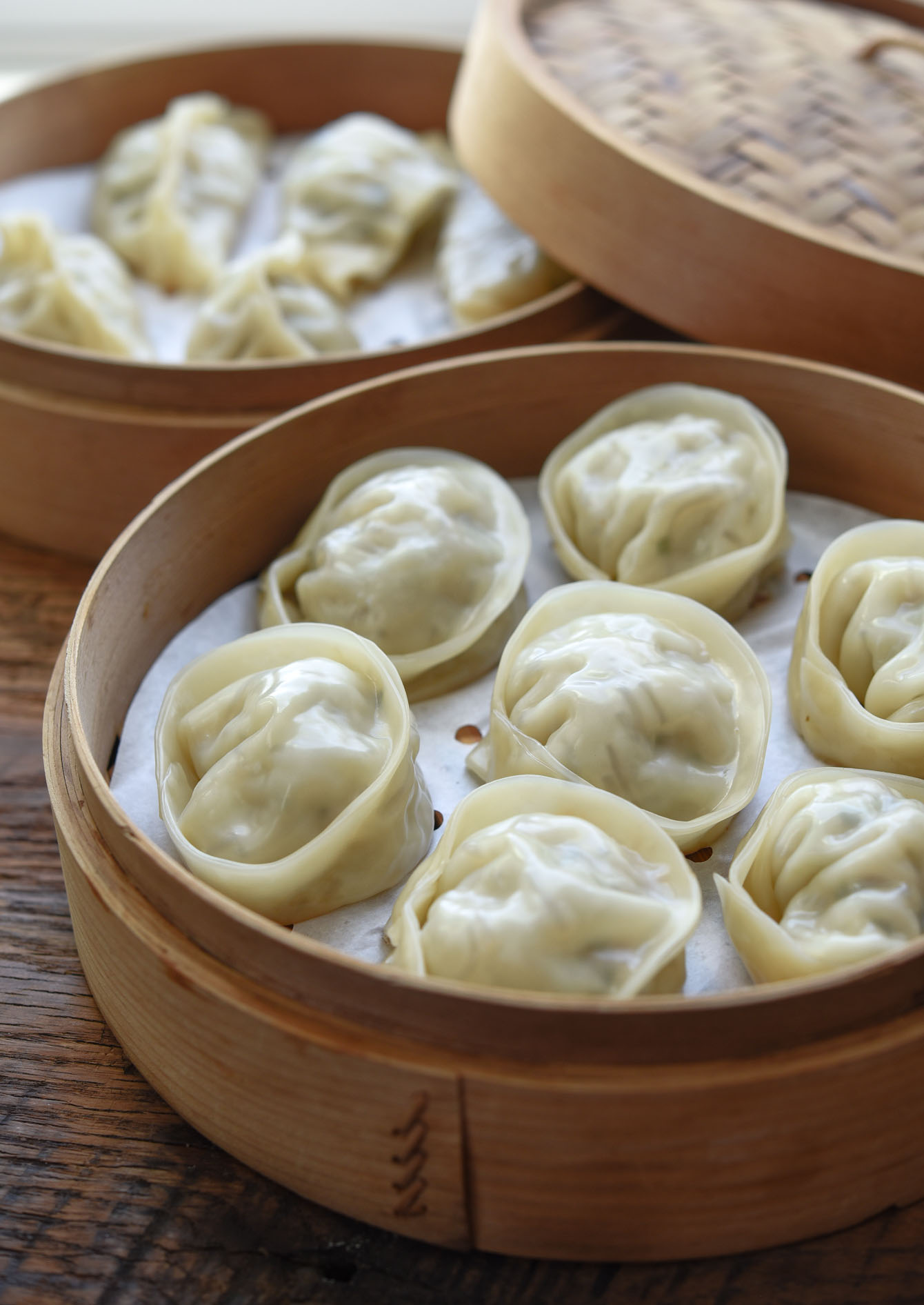

“I just made these today and my family LOVES them. I had to use dried chives instead of fresh Asian chives, and grape juice instead of sweet rice wine but it still tasted amazing to us. My great-aunt said that they tasted as good as restaurant dumplings. Thank you so much!”
Emma
In Korea, homemade mandu is a must-have for the Lunar New Year. These dumplings, filled with tasty meat and veggies, offer a bite full of satisfaction. But don’t just save mandu for the New Year—they’re perfect for any day.
Making mandu is a fun activity to do with your loved ones, turning an ordinary day into something special. So, gather your family and friends, and enjoy the simple pleasure of making and eating mandu whenever you fancy.
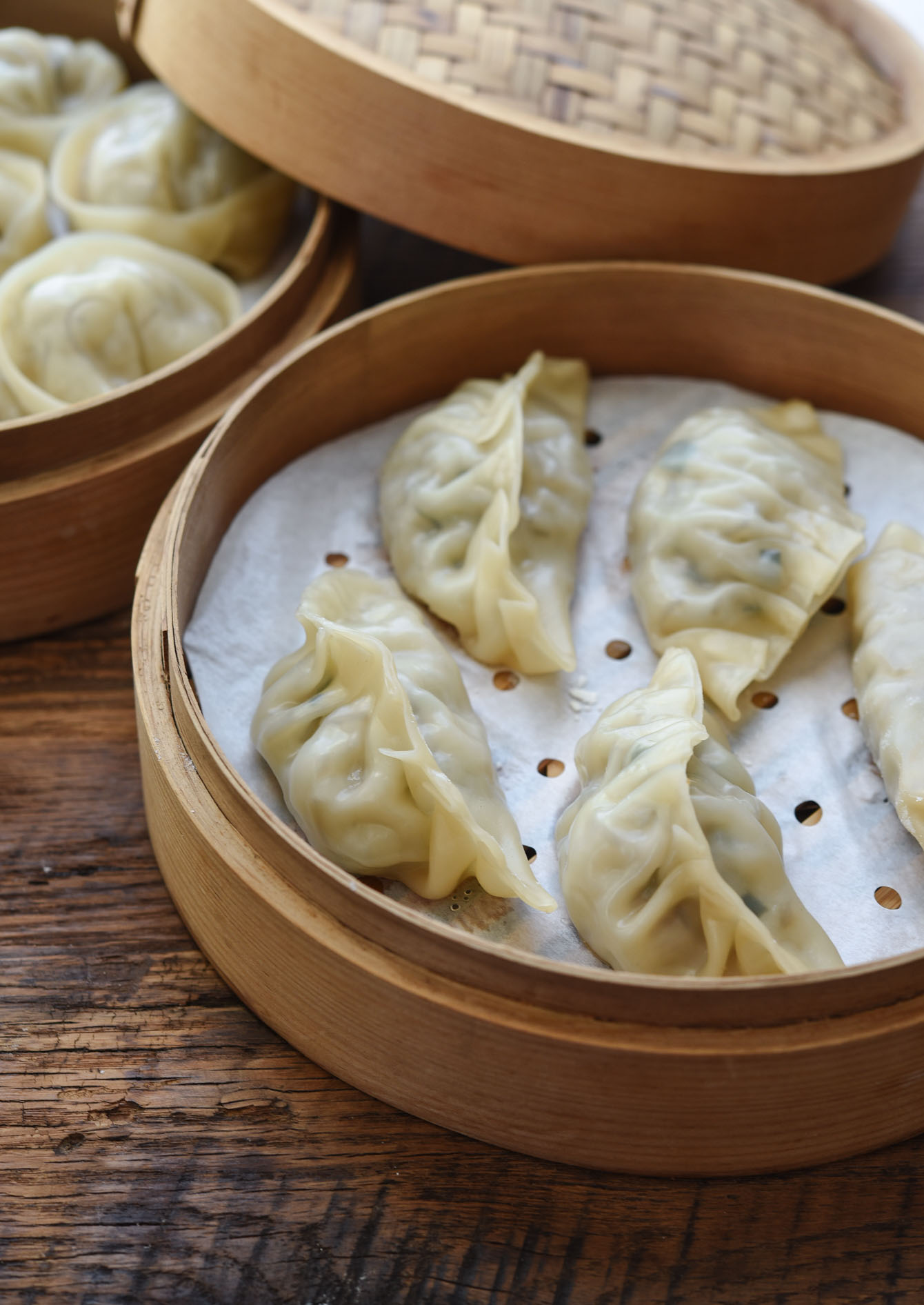

What is Mandu?
Mandu, or Korean dumplings, are a popular dish made by wrapping a thin dumpling dough around a savory mandu filling known as “mandu-so (만두소)”, and folded in different patterns. This filling usually includes ground meat, tofu, vegetables, and seasonings like garlic and green onions.
The process of making dumplings is simple and enjoyable, perfect for a family or any group activity. Once filled and sealed, mandu can be cooked in several ways—steamed, boiled, or fried to golden perfection.
These versatile Korean dumplings serve as a delicious appetizer or a part of a hearty meal, such as Korean dumpling soup (mandu-guk, 만두국) for the New Year celebration, or dumpling hotpot, offering a delightful sample of traditional Korean flavors.
Korean Lunar Year Tradition
My childhood memories of Lunar New Year are filled with helping my mother preparing Tteokguk (Korean rice cake soup) – the must have Lunar New Year food, along with Galbi-jjim (Korean braised ribs) or Bulgogi, Japchae, and etc . These Korean pork dumplings are one of them. I recall that she tried a different filling every year.
Creating homemade Korean mandu is a joyful family activity during the festive holiday. Being the heir, my father’s siblings, uncles, aunts, and cousins gathered at our house to celebrate.
Picture family members around the table, hands busy crafting tasty dumplings together, celebrating the new year’s beginning. These dumplings symbolize blessings for you and your loved ones.
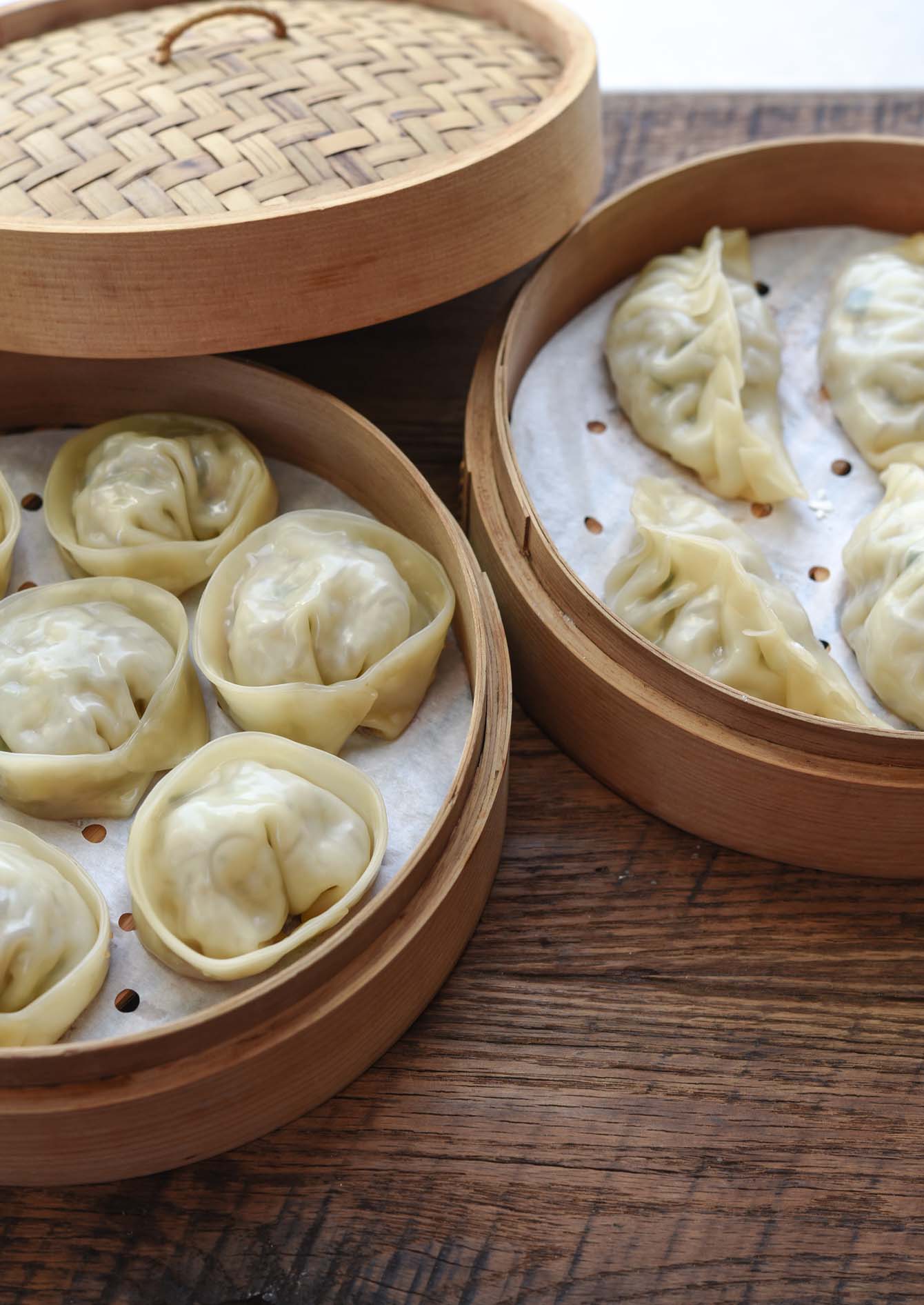

Mandu vs. Dumplings, Potstickers, and Gyoza
“Dumpling” is an umbrella term for stuffed dough creations found worldwide, including varieties like potstickers, gyoza, and mandu. Potstickers, a Chinese favorite, are crispy on the bottom and chewy on top, while gyoza, their Japanese relatives, are known for their thin wrappers and subtle seasoning.
Mandu, on the other hand, is the Korean take on dumplings, with a distinctive mix of local flavors and ingredients. Each type reflects its cultural roots through specific fillings, seasonings, and cooking methods, with mandu being Korea’s unique contribution to the global family of dumplings.
Mandu Variation
When it comes to the variety of mandu, Korean dumplings offer flavors for every taste. Gogi mandu is a meat-lover’s delight, typically filled with juicy beef or pork with savory vegetables.
Yachae mandu is a vegetarian’s dream, packed with fresh vegetables like mushrooms, tofu, and glass noodles, making it both flavorful and filling. Saewu mandu brings a taste of the sea with its shrimp filling, often mixed with green onions and ginger for that extra zing.
Then there’s the zesty kimchi mandu, where the star ingredient is kimchi, often combined with tofu to create a dumpling that’s both spicy and soft.
Korean Dumpling Made from Scratch
Making homemade mandu dumplings has two components; dumpling wrappers and dumpling filling.
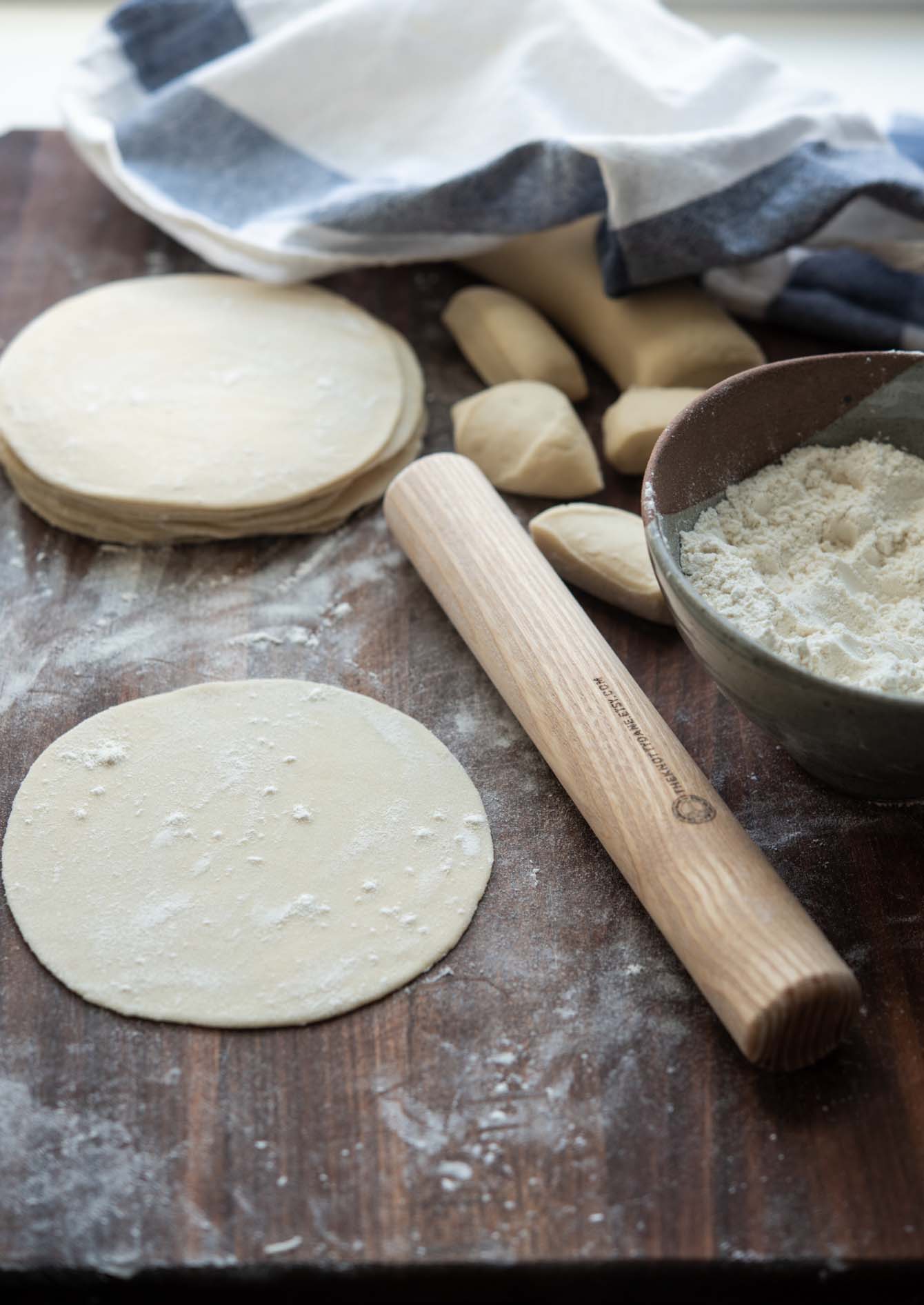

Dumpling wrappers (mandu-pi, 만두피)
Don’t be afraid to make homemade dumpling wrappers from scratch. My recipe blends flour, sweet rice flour, and cornstarch for that special tender and chewy texture. If you’re short on time, store-bought wrappers can work too—just choose the larger size (about 5 inches in diameter) for a true Korean-style mandu.
Dumpling filling (Mandu-so,만두소)
Traditional Korean mandu features minced pork with a juicy taste that pairs well with veggies like kimchi and tofu. For the best filling, use ground pork with some fat—about an 80/20 mix—to keep your dumplings moist and flavorful, avoiding the dryness that comes with leaner meat.
Ingredients for Dumpling Filling
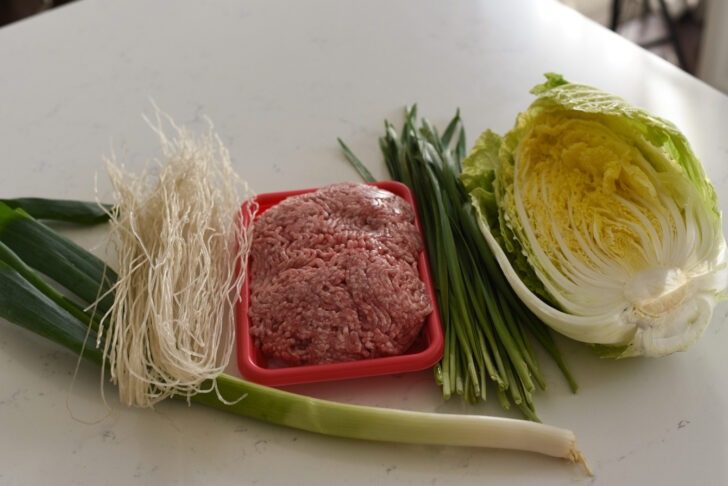

- Ground Pork: The foundation of mandu filling. Opt for an 80/20 meat-to-fat ratio for a juicier texture.
- Nappa Cabbage: Adds a sweet, slightly peppery crunch to the mix.
- Asian Chives: Bring a mild onion-like flavor, enhancing the overall taste.
- Asian Leek or Green Onion: Offers a depth of flavor with its sharp, earthy notes.
- Korean Glass Noodles (Dangmyun): Contribute a pleasant chewy texture to the filling, unique to Korean cuisine.
- Check out my easy japchae recipe for another idea of using Korean glass noodles.
How to make Mandu (Korean dumpling)
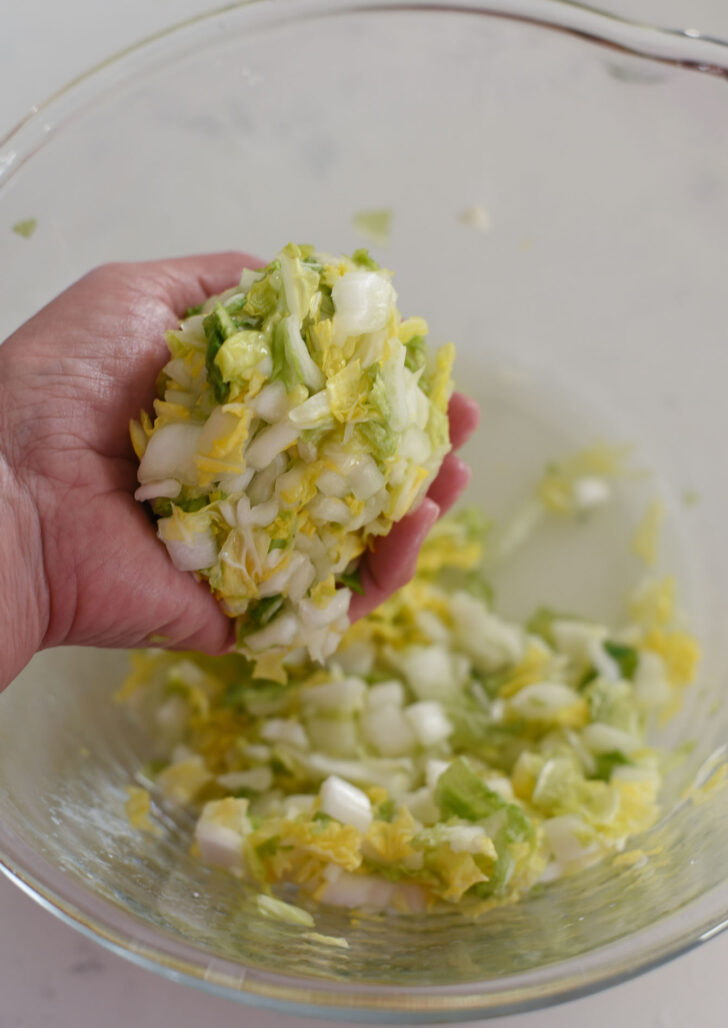

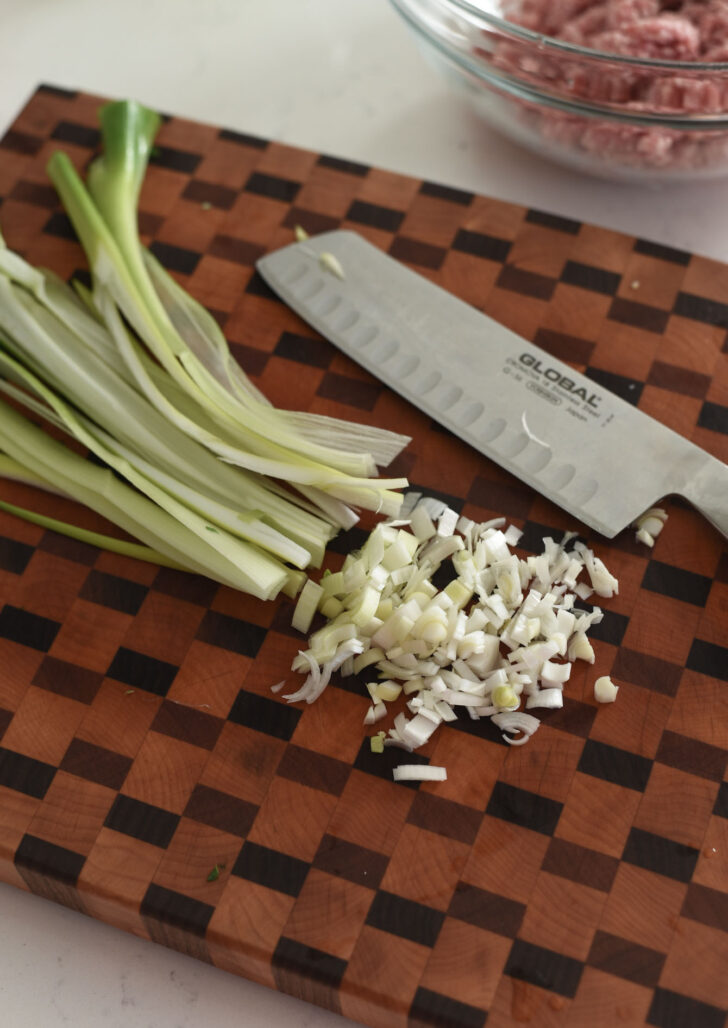

Preparing Cabbage and Herbs for Mandu Filling:
- Sprinkle a teaspoon of salt over the chopped cabbage and leave it to soak for 10 minutes. Once the cabbage has wilted, give it a good squeeze to remove excess moisture.
- For the chives and leeks, chop them finely. Should Asian chives be unavailable, simply use a larger quantity of green onions as a substitute.
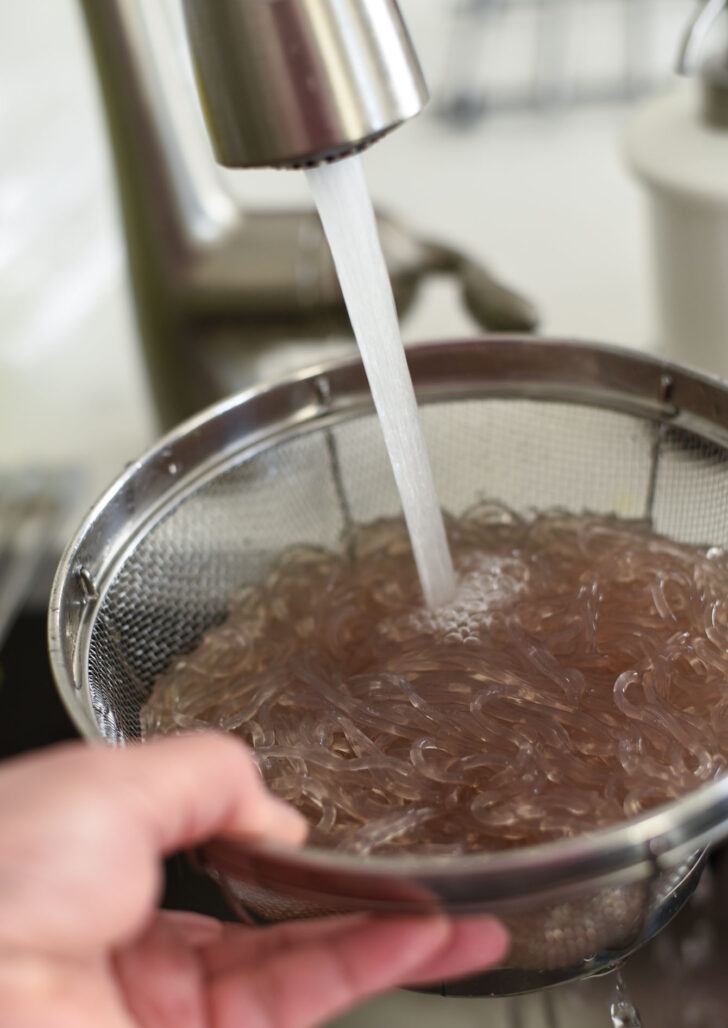

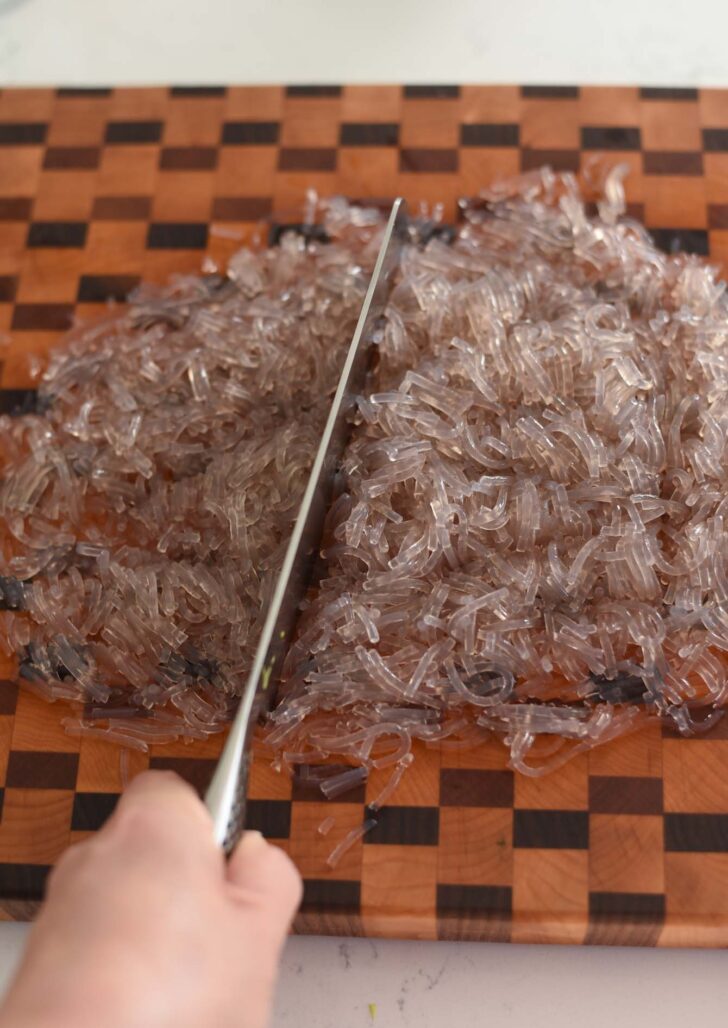

Cooking Korean Glass Noodles (Dangmyeon):
- Cook the Korean glass noodles as instructed on the package, typically for 6-7 minutes. After boiling, rinse them under cold water and ensure they’re well-drained.
- Then, chop the noodles into small, bite-sized pieces.
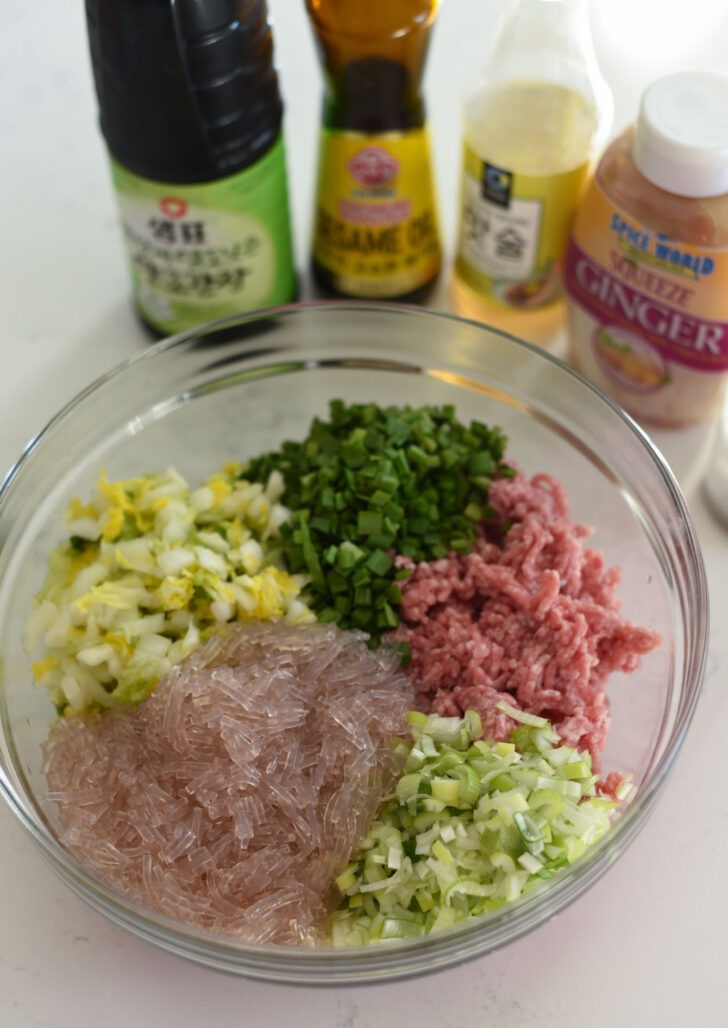

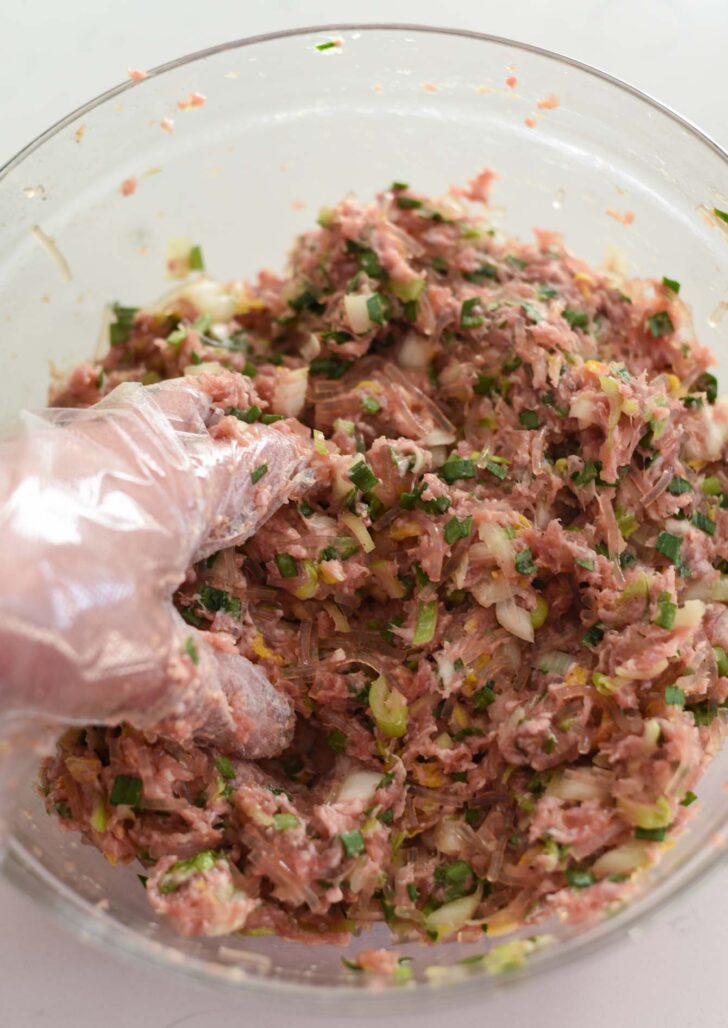

Mixing Mandu Ingredients:
- Combine pork, cabbage, chives, leek, and noodles in a large bowl. Add soy sauce, sweet rice wine, ginger, sesame oil, and pepper to the mix.
- Use your hands to blend everything thoroughly until the ingredients are fully integrated.
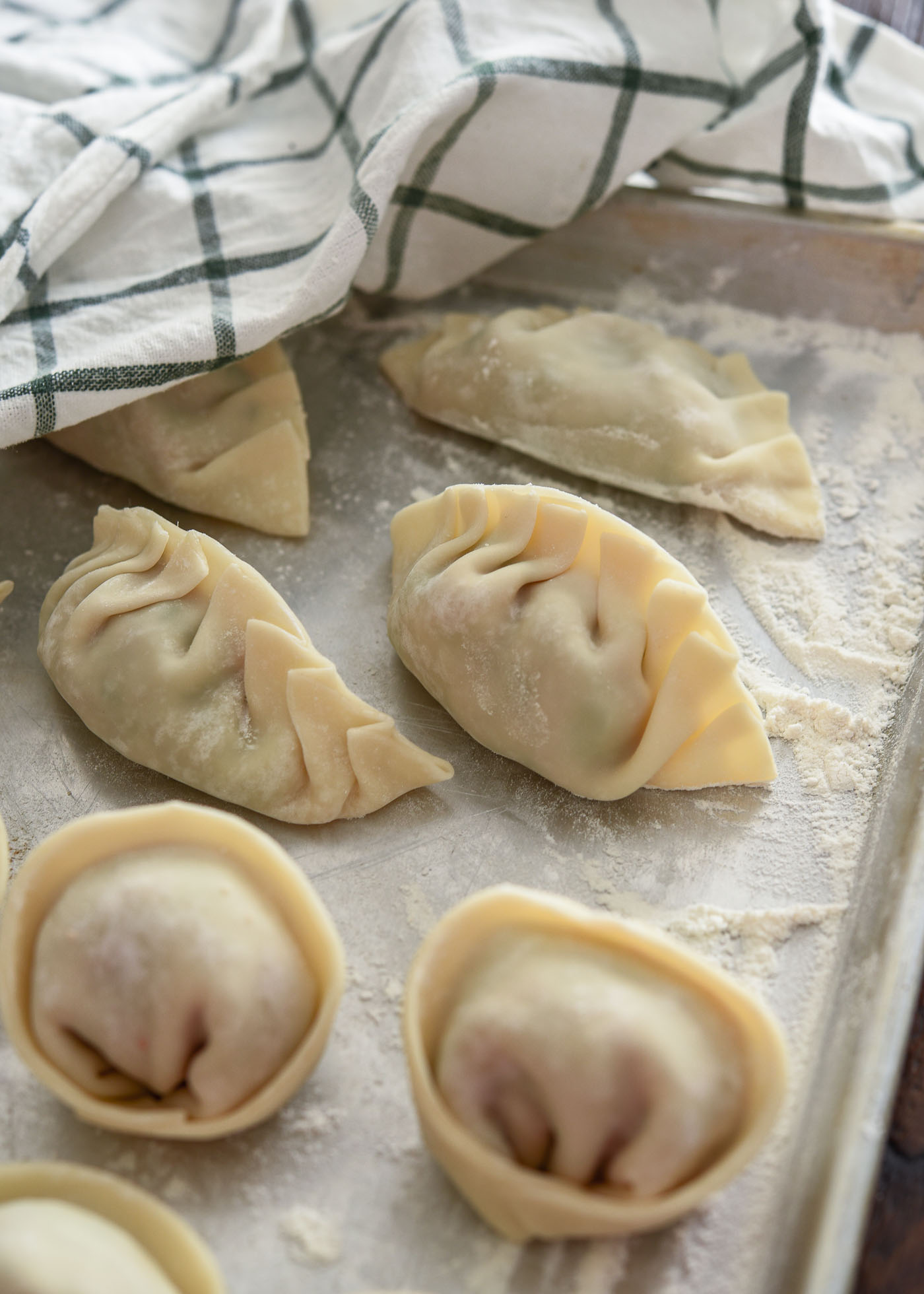

How to fold mandu
My mother used to say if you can fold a pretty dumplings, you will have a good looking son. If you can make Korean sweet rice cakes (Songpyeon) into a perfect shape, you will have a pretty daughter.
I think she was right! I do have a good looking son and a pretty daughter.
There are so many different shapes and patterns of folding dumplings. Here are the two of the most popular and easy.
Moon shape
Moon shaped round dumplings are the most common in Korean dumplings. This shape is perfect for steaming and making soup.
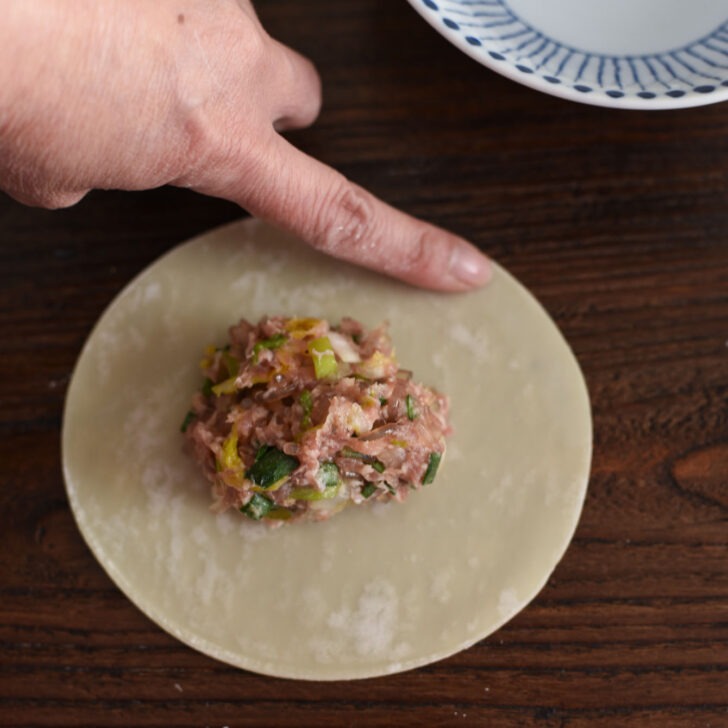

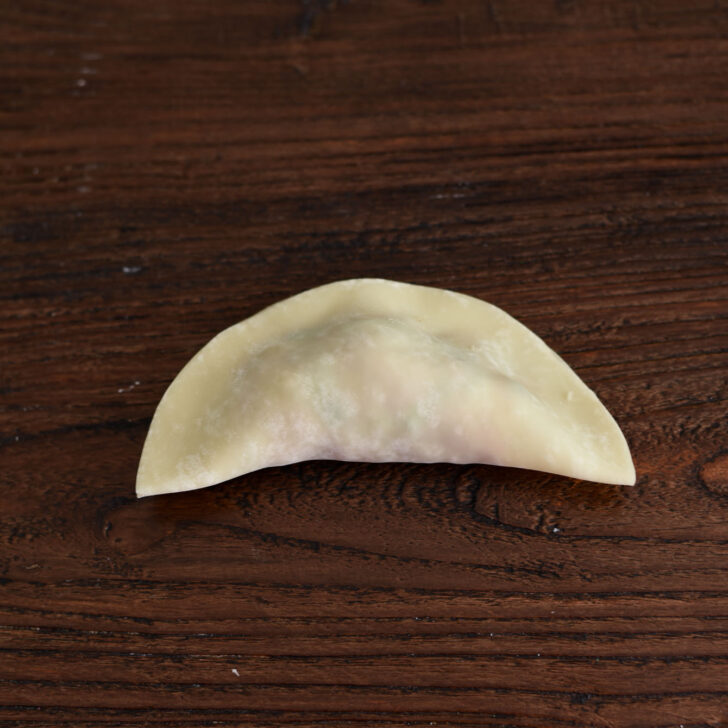

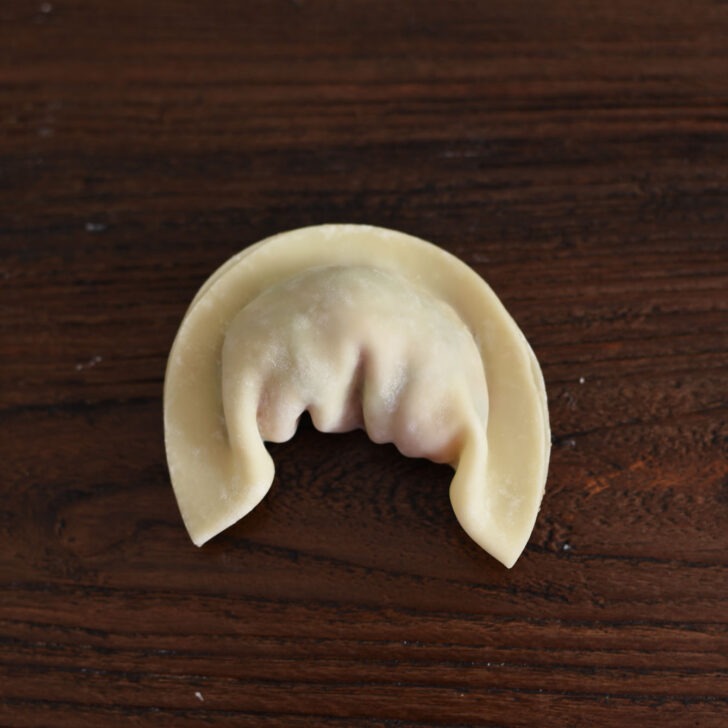

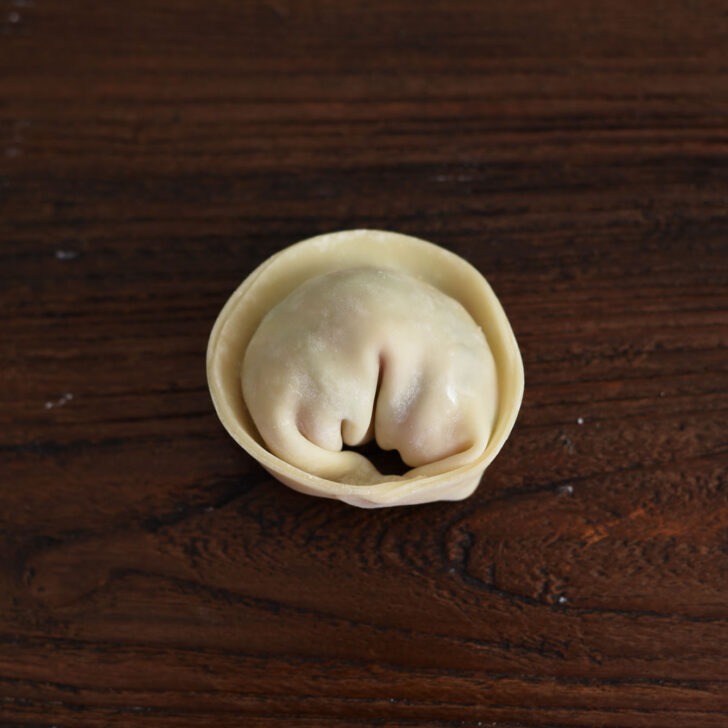

- Put a heaping tablespoon of filling in the middle of wrapper, wet the edges of wrapper with water using your finger.
- Fold the wrapper in half and pinch the edges together.
- Bring the both ends toward the center.
- Pinch the ends together to complete.
Pleated shape
Pleated shape is a great option for both steamed and pan fried dumplings. If you have never folded dumplings before, try with a small amount of filling inside first.
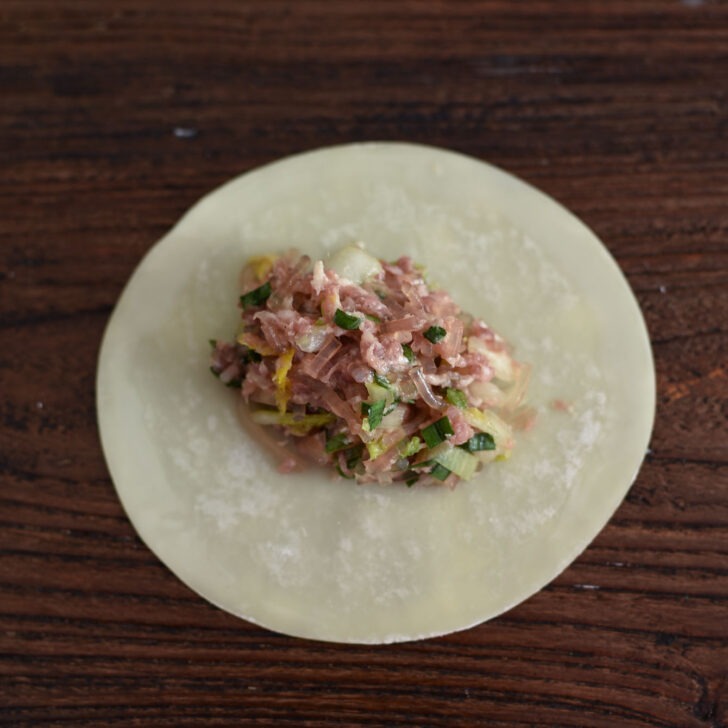

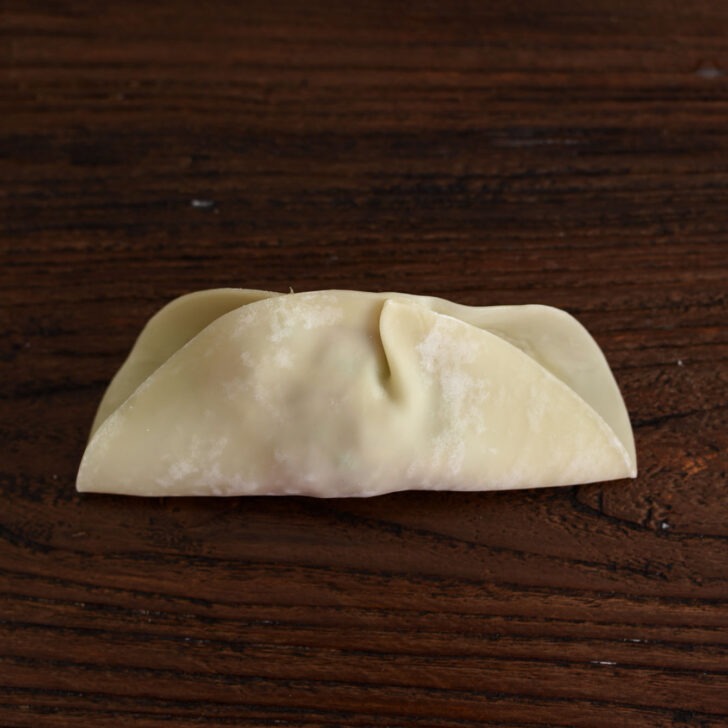

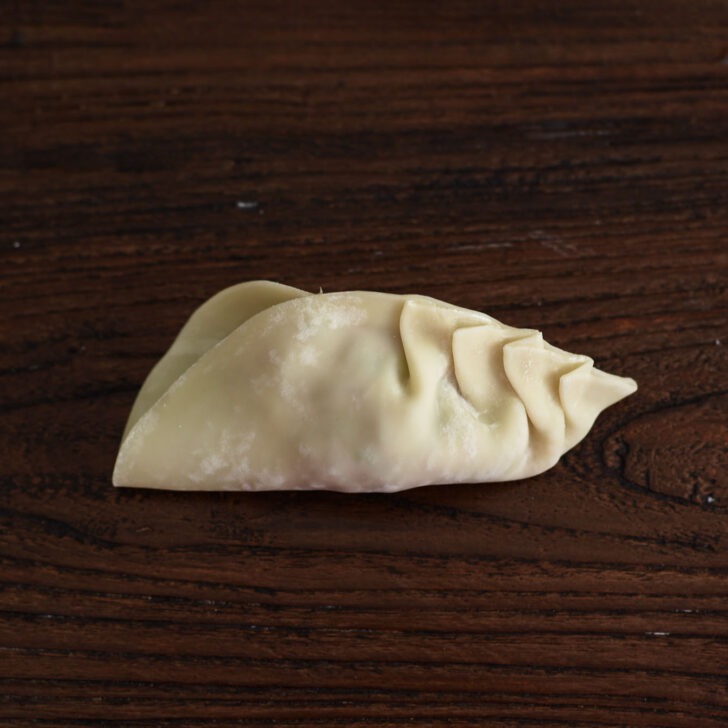

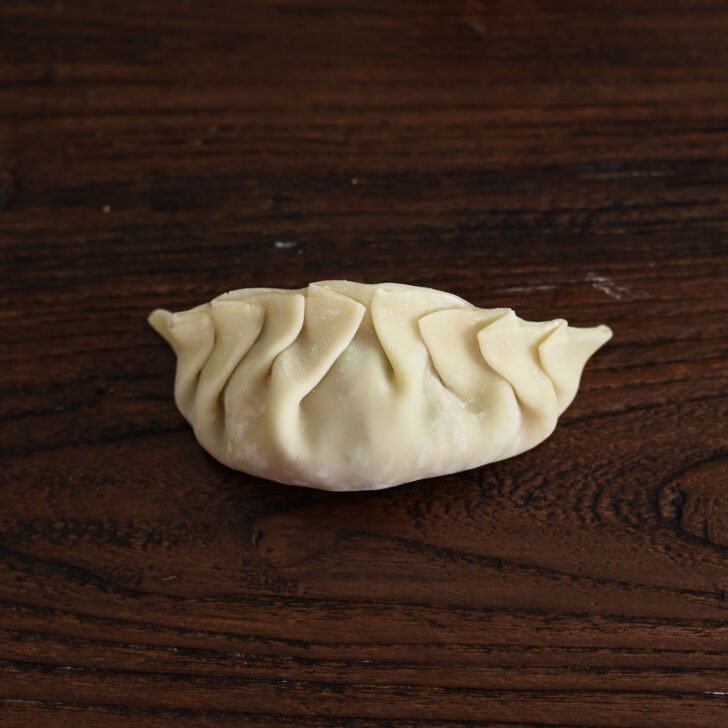

- Put some filling in the middle of the wrapper and wet the edges with water using your finger.
- Bring one edge to the other and pinch in the center first, then make a small pleat on one side facing toward the center .
- Continue to make more pleats, usually about 4 pleats.
- Create the same number of pleats on the other side, facing the pleats toward the center.
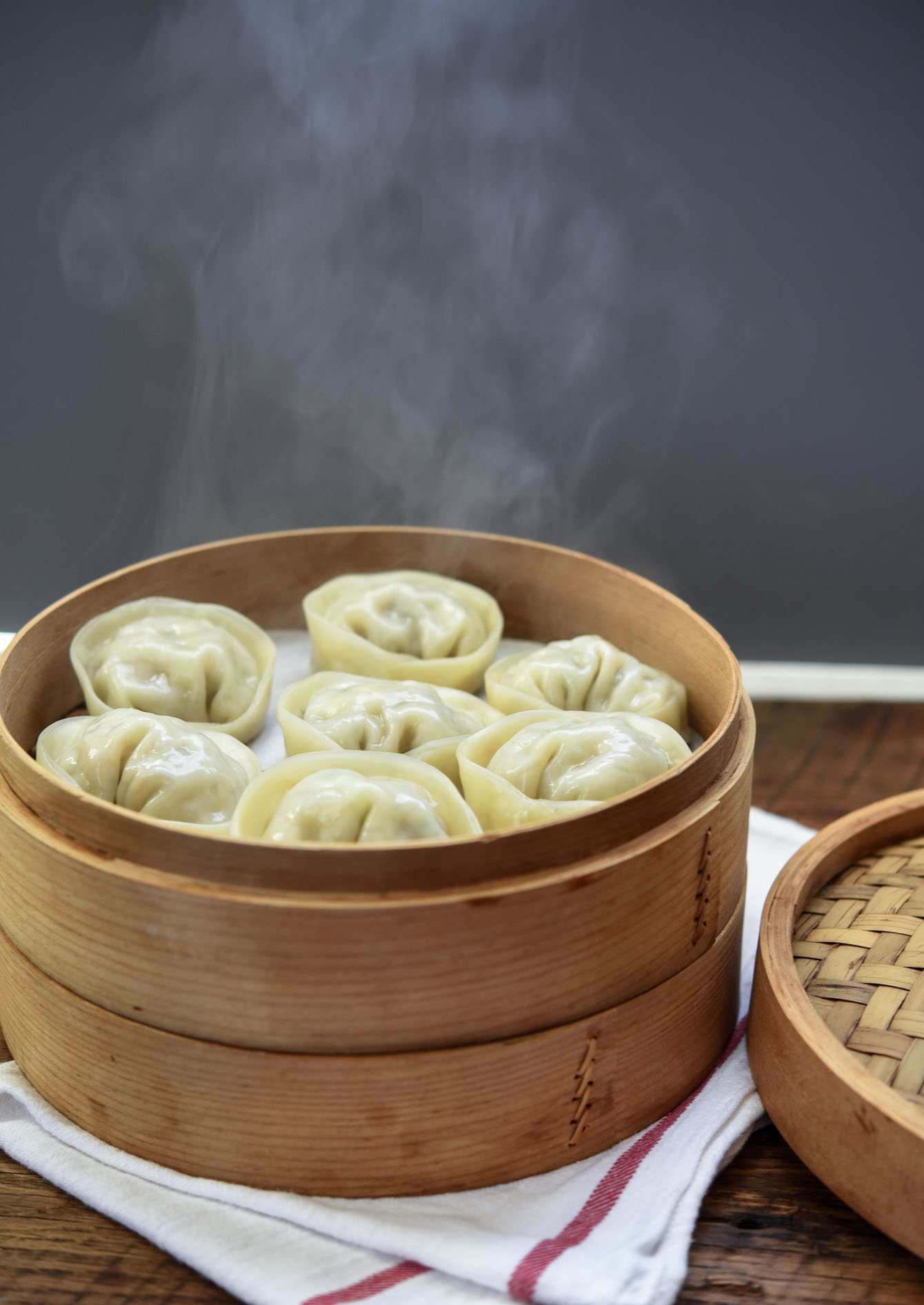

Cooking Methods for Mandu
Mandu can be cooked in a variety of ways, each method bringing out different textures and flavors.
- Steamed Mandu (jjin-mandu, 찐만두): Steaming preserves their delicate flavor and soft texture, making it a healthy cooking choice. This method steams the dumplings evenly, ensuring they come out perfectly tender without being waterlogged.
- To steam, set a bamboo steamer or other steamer over simmering water. It’s important to line the steamer with a steam liner or kitchen cloth to prevent sticking.
- Pan-Fried Mandu (Gun-mandu, 군만두): Pan-frying transforms mandu into a textural delight with a crispy exterior and chewy interior.
- Heat oil in a pan, place the dumplings flat-side down, and cook until the bottom turns golden brown.
- A splash of water and a quick cover with a lid will steam the tops, giving you the perfect crispy-chewy combination.
- Deep-Fried Mandu (Tuigim-mandu, 튀김만두): Deep-frying gives mandu a golden crunch that’s hard to resist. Submerge the dumplings in hot oil and fry until they are uniformly golden and crispy.
- This method is ideal for those who crave a richer flavor and a crunchy bite.
- Boiled Mandu (Mul-mandu, 물만두): This is the simplest method, yielding soft, versatile dumplings that are comforting to bite into.
- Drop the mandu into a pot of boiling water and cook until they float to the surface, indicating they’re ready to be enjoyed in your favorite soup or with a dipping sauce on the side.
Mandu dipping Sauce
Korean dumpling dipping sauce is a mixture of 2 parts soy sauce, 1 part vinegar, and 1-2 teaspoons of Korean chili flakes (gochugaru) for a little spice. This simple sauce is salty, tangy, and has a hint of heat. It’s just right for dipping your hot, juicy mandu.
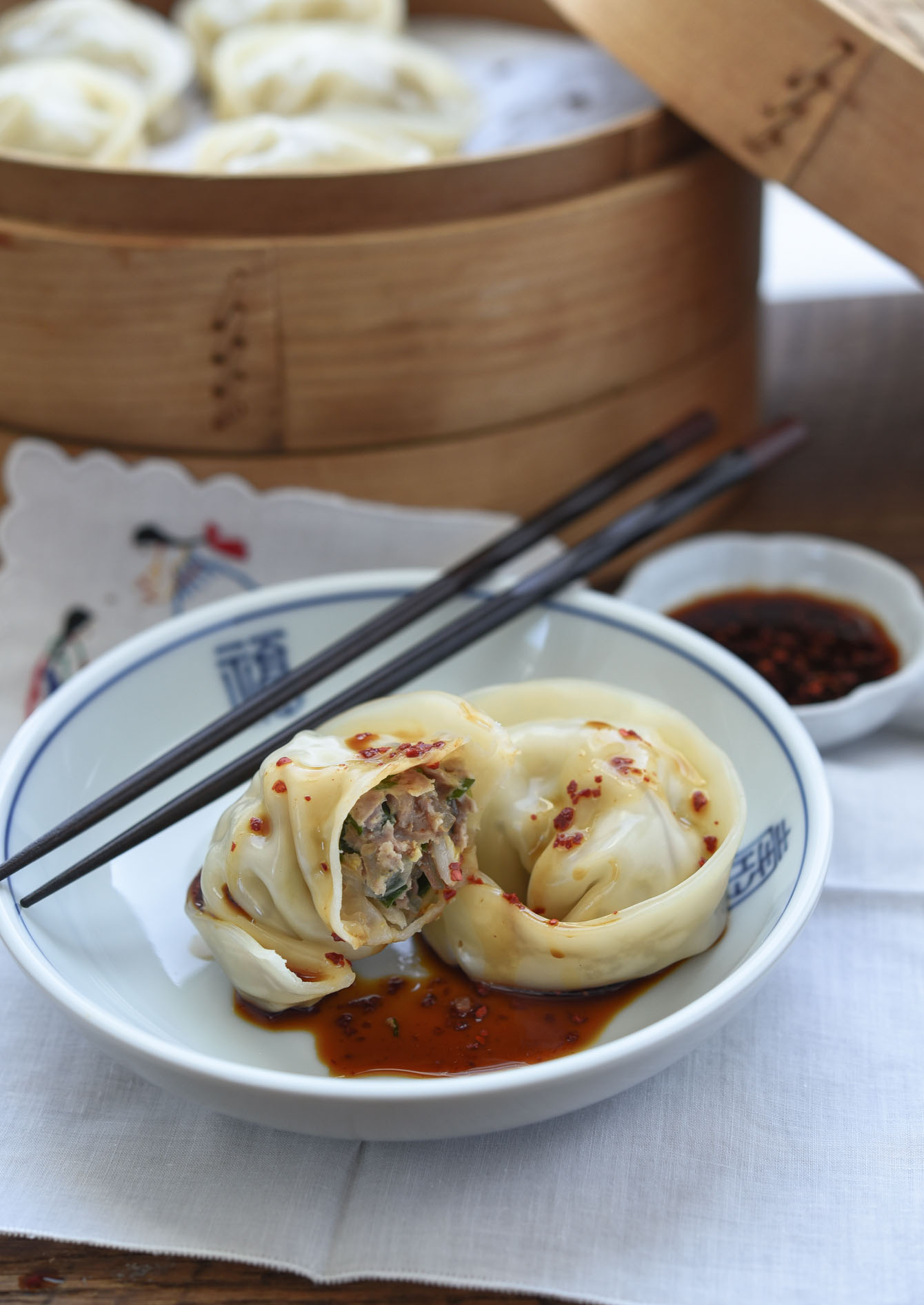

Freezing Tips
It is always a good idea to make abundant homemade dumplings because they freeze beautifully. Make sure to sprinkle flour on a large tray so that they won’t stick to the tray.
Place dumpling pieces on the floured tray without touching each other. Put them in the freezer for an hour or until they freeze solid. Transfer the individual pieces to freezer bags. They can last up to 3 months in the freezer.
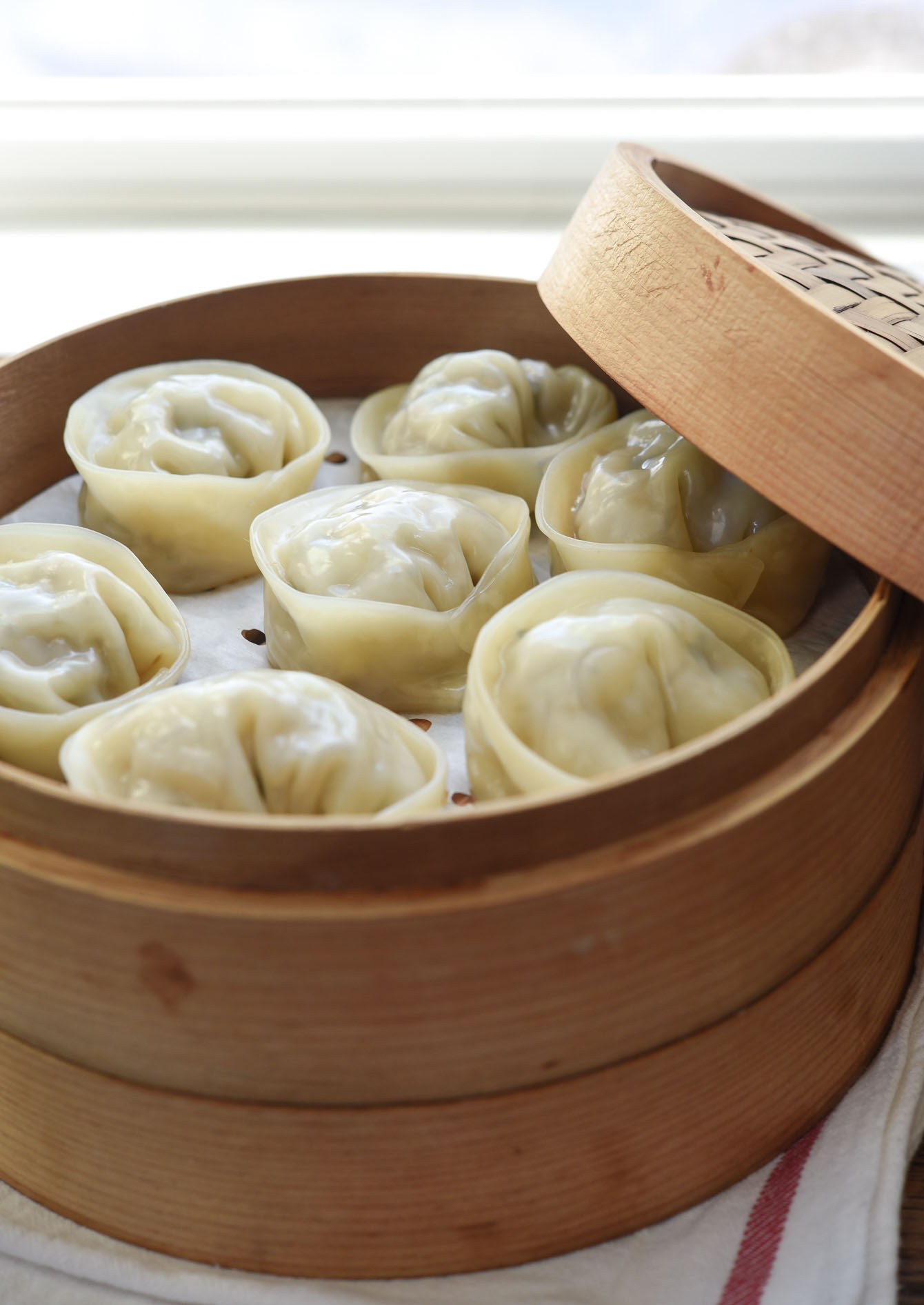

More Authentic Korean Recipes
If you are a Korean food enthusiast, here are a few of authentic Korean recipes that you can easily make at home.
Love this recipe? Rate it and share your experience in the comments below! On Instagram? Tag me to showcase your creation. For more delicious recipes, subscribe to our newsletter!
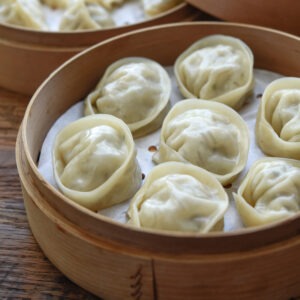

Homemade Mandu (Korean Dumplings)
To make the mandu filling
-
Chop napa cabbage very finely and put it in a mixing bowl. Sprinkle 1 tsp salt and toss together; let it sit for 10 minutes. When the cabbage becomes lifeless, squeeze it out to get rid of moisture.
-
Boil Korean sweet potato noodles according to the package directions, about 6-7 minutes. Rinse in cold water and drain well. Chop into small pieces.
-
Put pork, cabbage, chives, leeks, and noodles in a large mixing bowl. Season with soy sauce, sweet rice wine, ginger, sesame oil, and pepper; mix well with your hand until all the ingredients are well incorporated.
To shape half moon dumplings
-
Put a heaping tablespoon of filling in the middle of wrapper, wet the edges of wrapper with water using your finger. Fold the wrapper in half and pinch the edges together. Bring the both ends toward the center. Pinch the ends together to complete.
To shape pleated dumplings
-
Put some filling in the middle of the wrapper and wet the edges with water using your finger. Bring one edge to the other and pinch in the center first, then make a small pleat on one side facing toward the center. Continue to make more pleats, usually about 4 pleats. Create the same number of pleats on the other side, facing the pleats toward the center.
To steam the mandu (dumplings)
-
Bring a small amount of water in a large pot to boil. Make sure the bottom of your steamer doesn’t touch the water. Place mandu without touching each other in a bamboo steamer (or regular steamer), lined with a cheese cloth or a steam liner. When the water boils, place the steamer over or in the pot. Cover and steam for 5 minutes. Serve immediately.
-
Meanwhile, make dipping sauce to go with dumplings. Combine all the sauce ingredients and drizzle it over dumplings.
Freezing Tip: sprinkle flour on a large tray so that the dumpling won’t stick to the tray. Place dumpling pieces on the tray without touching each other. Freeze for an hour or until they are frozen solid. Transfer dumpling pieces to a freezer bag. They can last up to 3 months in the freezer.
Calories: 425kcal, Carbohydrates: 38g, Protein: 21g, Fat: 21g, Saturated Fat: 7g, Polyunsaturated Fat: 3g, Monounsaturated Fat: 9g, Cholesterol: 65mg, Sodium: 1357mg, Potassium: 545mg, Fiber: 3g, Sugar: 3g, Vitamin A: 1822IU, Vitamin C: 30mg, Calcium: 105mg, Iron: 4mg

